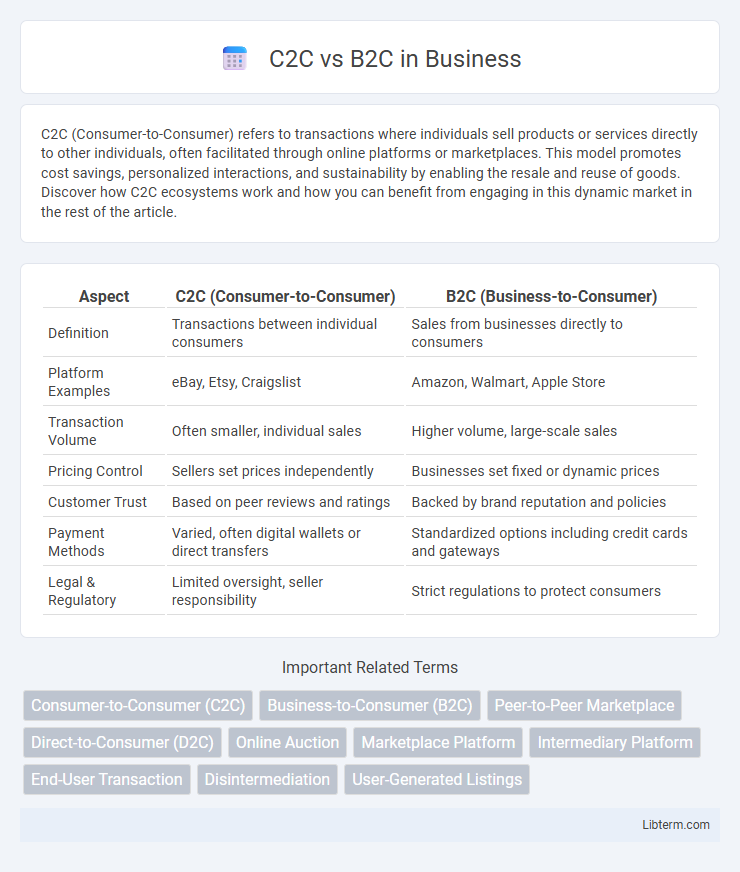C2C (Consumer-to-Consumer) refers to transactions where individuals sell products or services directly to other individuals, often facilitated through online platforms or marketplaces. This model promotes cost savings, personalized interactions, and sustainability by enabling the resale and reuse of goods. Discover how C2C ecosystems work and how you can benefit from engaging in this dynamic market in the rest of the article.
Table of Comparison
| Aspect | C2C (Consumer-to-Consumer) | B2C (Business-to-Consumer) |
|---|---|---|
| Definition | Transactions between individual consumers | Sales from businesses directly to consumers |
| Platform Examples | eBay, Etsy, Craigslist | Amazon, Walmart, Apple Store |
| Transaction Volume | Often smaller, individual sales | Higher volume, large-scale sales |
| Pricing Control | Sellers set prices independently | Businesses set fixed or dynamic prices |
| Customer Trust | Based on peer reviews and ratings | Backed by brand reputation and policies |
| Payment Methods | Varied, often digital wallets or direct transfers | Standardized options including credit cards and gateways |
| Legal & Regulatory | Limited oversight, seller responsibility | Strict regulations to protect consumers |
Introduction to C2C and B2C Models
C2C (Consumer-to-Consumer) and B2C (Business-to-Consumer) are two distinct e-commerce models shaping online transactions. C2C platforms like eBay and Craigslist facilitate direct sales between individual consumers, enabling peer-to-peer exchange of goods and services. B2C models, exemplified by Amazon and Walmart, involve businesses selling products or services directly to consumers, emphasizing scalability and brand-driven marketing strategies.
Key Differences Between C2C and B2C
C2C (Consumer-to-Consumer) involves direct transactions between individual consumers, often facilitated by online marketplaces like eBay or Craigslist, whereas B2C (Business-to-Consumer) consists of businesses selling products or services directly to consumers, exemplified by retailers such as Amazon and Walmart. Key differences include seller identity, with C2C driven by individuals and B2C by established companies, as well as transaction scale and customer service levels, where B2C typically offers greater product variety, consistent quality control, and professional support. Payment processing and trust mechanisms also differ, with C2C relying heavily on platform reputation and peer feedback, while B2C employs secure payment gateways and formal return policies.
Advantages of the C2C Model
The C2C model leverages peer-to-peer transactions, reducing overhead costs and enabling competitive pricing through direct seller-to-buyer interaction. It fosters a diverse marketplace with unique, often secondhand or handmade products that are not typically available in traditional B2C channels. Enhanced trust mechanisms such as user ratings and reviews increase transparency and encourage a community-driven approach to commerce.
Benefits of the B2C Model
The B2C model streamlines transactions by connecting businesses directly with consumers, enhancing convenience and efficiency. This approach allows for personalized marketing strategies, tailored to individual consumer preferences, boosting customer engagement and loyalty. Increased scalability and brand visibility are also key advantages, driving higher sales volumes and market penetration.
Challenges Faced by C2C Platforms
C2C platforms face challenges such as ensuring trust and safety between individual buyers and sellers, managing payment security without a centralized authority, and handling disputes that arise from transactions of varying quality and reliability. The lack of standardized product information and inconsistent user experiences often result in lower customer retention compared to B2C platforms. Moreover, C2C marketplaces struggle with fraud detection and maintaining compliance with diverse regulatory requirements across different regions.
Common Issues in B2C Transactions
B2C transactions often face common issues such as payment security risks, order fulfillment delays, and challenges in customer service responsiveness. Consumers frequently encounter problems with product quality discrepancies and return policy misunderstandings, leading to decreased satisfaction and trust. Efficient inventory management and clear communication channels are crucial to mitigate these issues and enhance the overall B2C shopping experience.
Popular C2C Platforms Examples
Popular C2C platforms include eBay, Craigslist, and Facebook Marketplace, which facilitate direct transactions between individual sellers and buyers. These platforms leverage user-generated listings to enable peer-to-peer sales of goods ranging from electronics to collectibles. Compared to B2C models like Amazon and Walmart, C2C platforms emphasize community-driven commerce and secondhand market growth.
Leading B2C Companies in the Market
Leading B2C companies such as Amazon, Alibaba, and Walmart dominate the market by leveraging advanced logistics, personalized marketing, and extensive product catalogs to directly engage consumers. These enterprises capitalize on large-scale data analytics to optimize customer experience and tailor offerings, driving higher conversion rates compared to C2C platforms. B2C marketplaces benefit from established trust, reliable payment systems, and streamlined delivery, positioning them ahead in consumer retention and market share.
Choosing the Right Model for Your Business
Choosing the right model between C2C (Consumer-to-Consumer) and B2C (Business-to-Consumer) depends on your target audience and business goals. B2C models, optimized for scalability and brand control, suit businesses prioritizing direct sales and customer relationships, while C2C platforms excel in peer-to-peer marketplaces leveraging user-driven transactions. Analyze customer behavior, transaction volume, and product type to determine whether the efficiency of B2C or the community-driven engagement of C2C aligns best with your business strategy.
Future Trends in C2C and B2C Commerce
Future trends in C2C commerce emphasize enhanced peer-to-peer transactions through blockchain technology and decentralized platforms, boosting trust and security. B2C commerce is increasingly leveraging AI-driven personalization and immersive experiences like augmented reality to improve customer engagement and conversion rates. Both models are integrating omnichannel strategies and sustainable practices to meet evolving consumer demands and regulatory standards.
C2C Infographic

 libterm.com
libterm.com